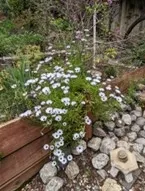With all the lovely rain we've been having I am continually surprised by what pops up each season. This year our Osteosperum ecklonis has gone wild!!

There are about seventy species of annual or perennial As you can tell by the picture above, this plant has showy flowers. This plant grows between 1'-3' high with a 1'-2' spread. It has many attractive qualities. It's low maintenance, drought tolerant, has vibrant showy flowers creating a stunning visual display. On top of that it has an extended blooming season that runs from the late spring to fall. The African Daisy is a pollinator attractor, attracting bees, butterflies, hummingbirds and other insects. It is drought tolerant as well. All of these attributes helps to support a healthy ecosystem and promotes biodiversity. African daisies can grow in many settings such as borders, garden beds, containers and rockeries. Because of its bushy growth habit it can exist in either large or small spaces. It is not toxic to either humans or animals.
Caring for this plant is easy as long as you follow certain guidelines. Water daisies regularly keeping the soil consistently moist while being careful not to waterlog it which can result in root rot. Underwatering could stress the plant and reduce its flowering potential. Fertilize using a balanced, slow release fertilizer or compost (which is what I use) being careful not to over do it. That will cause expansive foliage growth at the expense of the flowers. As with many plants lightly prune in early spring and late summer which causes bushier growth while maintaining its shape. Make sure the plant has enough room to spread by planting 12”-24” apart allowing for good air circulation and to prevent overcrowding. Lastly apply a 2”-3” layer of mulch around the base of the plant being careful to keep it away from the stem. You will be rewarded for following these guidelines with a plant that produces an abundance of flowers![4]
[1] Picture taken is by the author from a specimen in her garden.
[2] Sunset Western Gardener Book
[3] Hortus Third- A Concise Dictionary of Plants Cultivated in the U.S. & Canada- Staff of the L.H. Bailey Hortorium, Cornell University
[4] Website Gardenia Creating Gardens-“African Daisy: how to Grow and Care with Success

